CHAPTER 16
TRAINING DRILLS AND COMBAT STRATEGIES
The Cabales serrada system of escrima is characterized by fast, explosive movements rooted in acute reflex control and coordination. Practitioners train to develop the ability to strike with unpredictable suddenness. It is the attainment of this ability that facilitates the process of being able to defend against similarly deceptive attacks.
It is widely held that the hand is faster than the eye and, thus, one’s vision will be impaired when pitted against an opponent who possesses a great deal of speed, fine timing, and deceptive feinting skills. In Cabales serrada escrima, such attributes are developed through responsive training drills and applied through deceptive combat strategies. Daily practice of lock and block, flow sparring, picking, reversing, and sticky stick drills and the strategies outlined below, will improve any practitioner’s overall fighting ability and combat effectiveness.
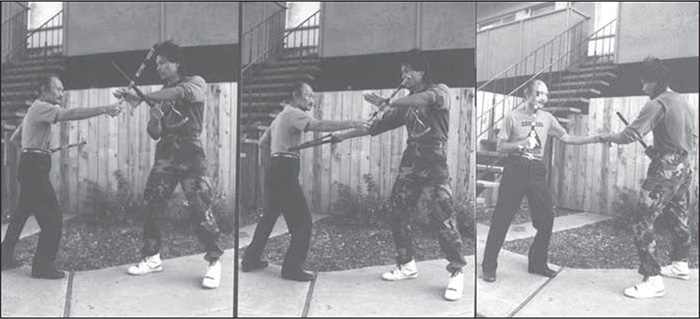
Lock and Block
Lock and block is a training drill that does much to increase the practitioner’s ability to effectively use this art in combat. It is a drill in which two partners face each other—one as attacker and the other as defender. The defender is armed with a long and short stick (or a stick and dagger), while the defender is armed only with a single stick. There are several levels to this drill, each building on the next, and each bringing the practitioner’s skills closer to being actual rather than assumed.
Throughout this drill, the defender’s goal is to block the initial stick attack, complete an entire counter sequence, and return to the “locked” fighting position held prior to the attacker’s initiation of his knife or short-stick thrust. At this level, the attacker is striking along the twelve strike sequence in the following manner: strike one, dagger thrust, strike two, pause; strike two, dagger thrust, strike three, pause; and so on through the twelve strikes. This level is concerned with developing the practitioner’s coordination and timing.
The next level of the lock and block drill finds the attacker delivering the twelve strikes and dagger thrusts consecutively, without pause, but this time not necessarily allowing the defender to complete each counter sequence. This level is concerned with developing the practitioner’s timing and reflexes. Since the practitioner does not know if or when the attacker will allow him to complete the counter sequence against each strike, the defender must assume he can finish and is at times forced to parlay one counterstrike into the next block. Again, the end of one movement becomes the beginning of the next.
The advanced and highest level of this drill finds the attacker executing any number of strikes desired in any chosen sequence. Again, the attacker may or may not allow the defender to complete counterattack sequences. This level of lock and block is fast and furious, and in addition to highly developing reflexes, speed, and timing, it also develops the ability to move and react spontaneously without thought.
Flow Sparring
Flow sparring is a drill that develops the practitioner’s fundamental skills in single-stick sparring. This drill initially finds its participants facing off and engaging in an even exchange of strikes and blocks. It is primarily employed as a tool to teach beginners how to block effectively and counterattack efficiently.
Flow sparring is initially taught in a prearranged sequence of movements to develop hand and foot coordination. The drill later progresses to a point where the strikes and counters may come from any angle, thus developing reflexes. In the latter stages, broken rhythm and feinting techniques are also employed in this drill, thus making it more realistic.
Picking
Picking (or faking) techniques are the icing on the serrada cake. “Picking” is a general term used within the system to describe the action of using deceptive strikes to open a target area that may otherwise be closed to an attack.
There are many types and methods of “picking,” and each angle has multiple variations. Here, Darren Tibon demonstrates “picks” from the first three angles of attack.
PICKING STRIKE ONE
When intending to “pick” strike one, be sure to chamber your stick long enough to alert your opponent to the fact that you are preparing to attack him from that angle (Figure 16-1). Allow your stick to move about two-thirds of the distance to its false target (Figure 16-2). As the opponent commits his defense (in this case, an inside block), change the angle of your attack and strike your opponent on his blocking hand (Figure 16-3). Immediately follow this with another change of angle (in the event that he is able to block your first feint), to strike his head or other unguarded target (Figure 16-4).
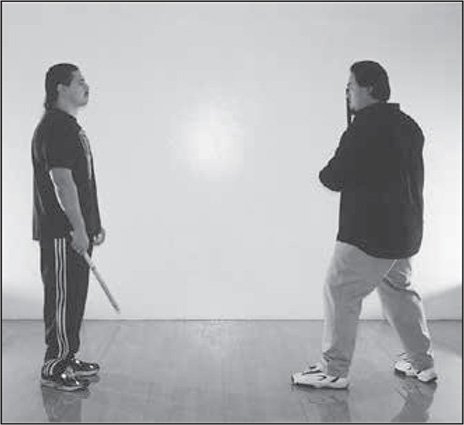
16-1
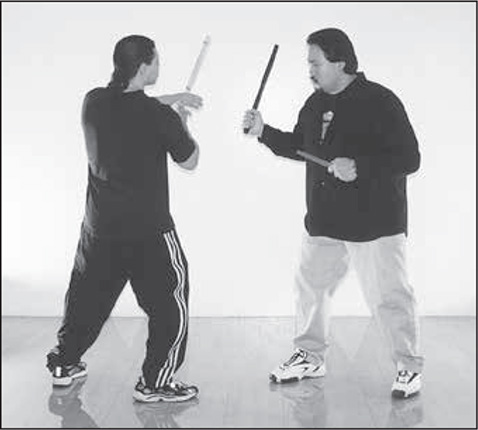
16-2
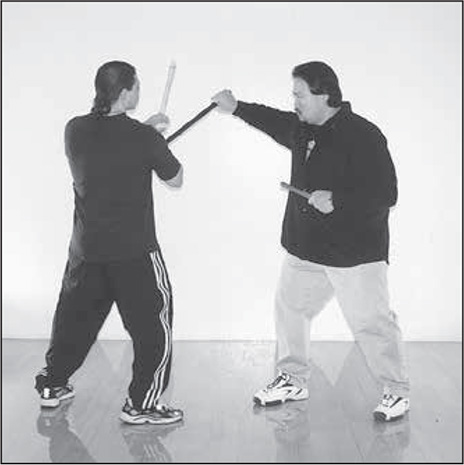
16-3
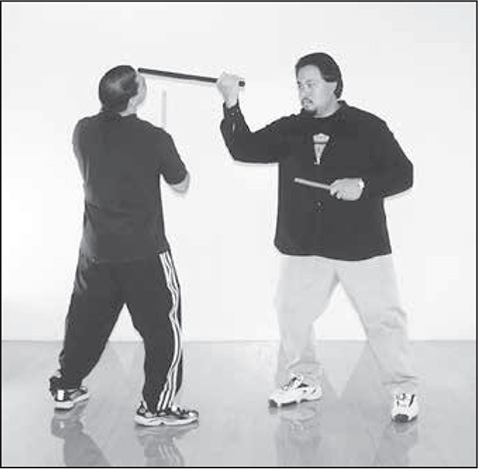
16-4
PICKING STRIKE TWO
When intending to “pick” strike two, be sure to chamber your stick long enough to alert your opponent to the fact that you are preparing to attack him from that angle (Figure 16-5). Allow your stick to move about two-thirds of the distance to its false target (Figure 16-6). As the opponent commits his defense (in this case, a roof block), change the angle of your attack and strike your opponent’s unguarded midsection (Figure 16-7).

16-5
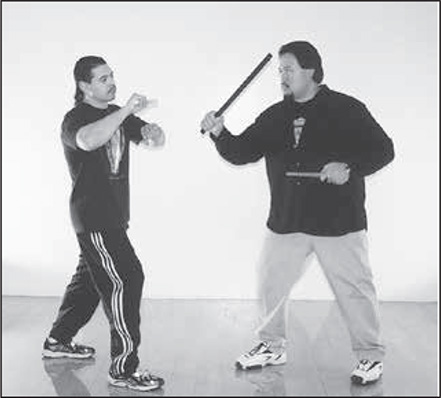
16-6
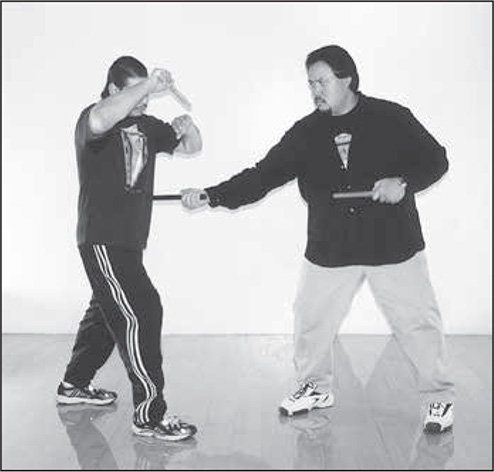
16-7
PICKING STRIKE THREE
When intending to “pick” strike three, be sure to chamber your stick long enough to alert your opponent to the fact that you are preparing to attack him from that angle (Figure 16-8). Allow your stick to move about two-thirds of the distance to its false target (Figure 16-9). As the opponent commits his defense (in this case, a cross block), change the angle of your attack and strike your opponent’s temple (Figure 16-10). Immediately follow this with another change of angle (in the event that he is able to block your first feint), and strike his throat (Figure 16-11).
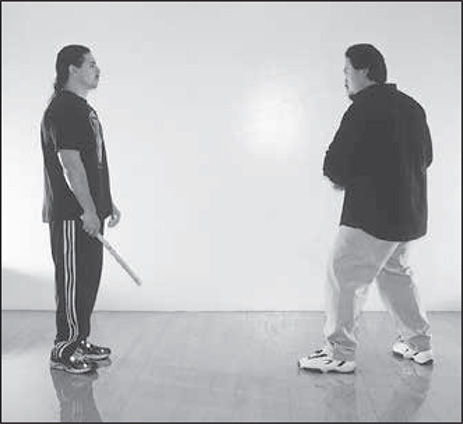
16-8
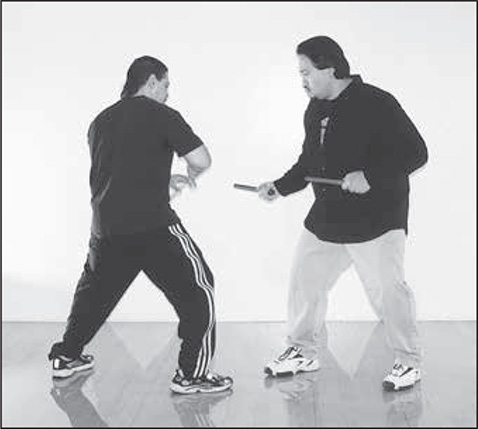
16-9
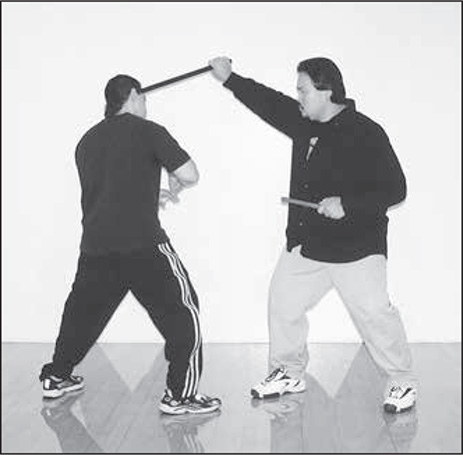
16-10
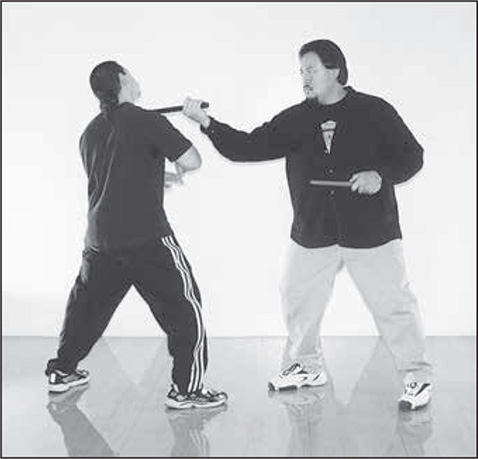
16-11
PICKING AS A TRAINING DRILL
Students are first taught how to properly execute the picks or feinting striking combinations and later how to defend against them as well. It takes a keen sense of timing and coordination to execute these techniques and an even greater reflex control and coordination to defend against an opponent’s onslaught of them. There exists no pattern to feinting techniques execution because these “picks” are predicated on being deceptive and unpredictable. The sequence of strikes is largely dictated by an opponent’s attacks, defensive movements, and general reactions to your movements.
Reversing
Reversing is the name given to the skills used in counterattacking a counterattack. In other words, if you strike an opponent and he blocks and counters you, your counter of his counter is known as a “reversal.” And while you may not literally be “reversing” any actual motion, you are attempting to reverse the outcome of the encounter with this approach.
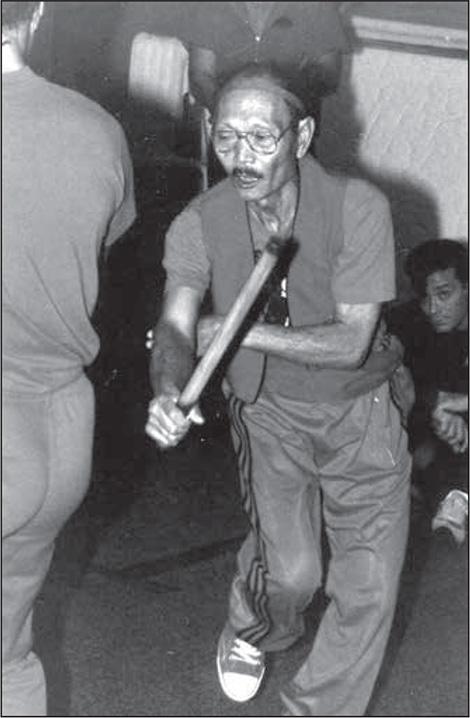
Angel Cabales “reverses” Kimball Joyce’s attack.
In the Cabales serrada system, there is a reversal for every movement in every counter. For example, against the standard inside block and counter for strike one, there is a reversal for the initial block, the horizontal counterstrike, the underhand wrist strike, the check, the overhand wrist strike, and the locking sequence. Thus, conceptually, reversing gives the serrada practitioner the ability to counter an opponent six different times and in six different ways against this very basic counter sequence.
The concept and strategy of reversing is an advanced part this art. And in an even more advanced line, there are methods of reversing every reversal an opponent may know and use against your counter to his counter. This is known as “reverse reversing.”
Sticky Stick
“Sticky stick” is an advanced combat strategy in Cabales serrada escrima that uses the opponent’s own weapon as a guide to striking his weapon-holding hand. As mentioned earlier, attacking the weapon-holding hand is the most basic and primary method of severely injuring and/or disarming an armed opponent, and thus a fast method of ending a confrontation.
The concept of “sticky stick” works like this: an opponent strikes, you move off his line of attack and block his stick with your stick, and rather than moving your stick away from his to counterstrike him, you maintain a check on his stick with your stick while sliding your stick down the shaft of his to the base, thereby striking his hand. This is an advanced counter method and combat strategy that is difficult to defend against. And since your stick never looses contact with your opponent’s, there is no block that can be employed to defend against it. What is available, however, are reversing maneuvers.